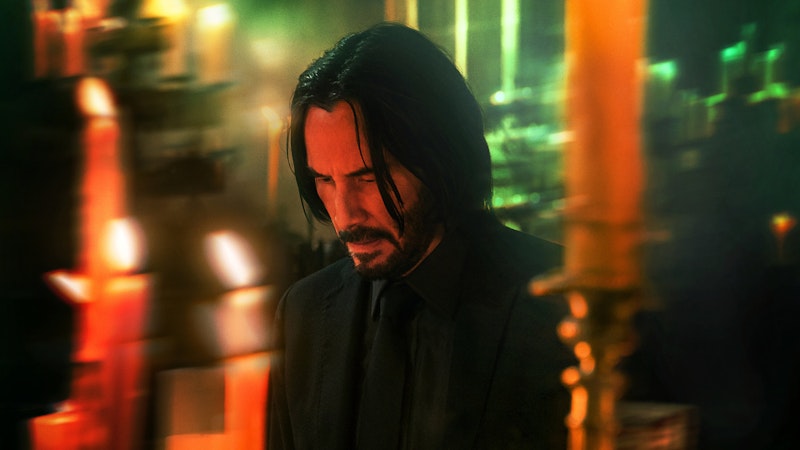In an era where blockbuster films are judged exclusively in terms of their franchise potential, John Wick proved to be the strangest and most pleasantly idiosyncratic success story of the bunch. The first installment was nearly consigned to the direct-to-video bins under the bizarrely-chosen title Scorn, having failed to secure a distributor until Summit Entertainment stepped in at the 11th hour.
The story (what little of it there is) was exactly the sort of thing DTV has regrettably become the last haven for: a refreshingly stripped-back, no-nonsense revenge flick about a wronged man and all the bullets and bad guys that stand between him and retribution. They killed his dog and stole his ride, who the fuck else are you going to root for? While it teased an elaborate criminal underworld over the course of its lean 90-minute runtime, its scope and ambitions were modest; anchored by decades of mythological genre baggage attached to leading man Keanu Reeves, its impressive roster of bit players (always nice to see David Patrick Kelly getting work), and honed by the symbiosis of Reeves in front of the camera and his former Matrix stuntman Chad Stahelski behind it.
With the second film, the core principle of manly men doing manly revenge was playfully abstracted into the realm of the mythic; setting the action against an impressive backdrop of historic architectural icons and artworks, turning the series’ already larger-than-life characters into Greek heroes, and subverting the journey of its protagonist into a surprisingly pessimistic descent into figurative and literal Hell. A thematic and aesthetic trend which the third film increased. In case there were any doubts as to where we now stand, the fourth film begins with Laurence Fishburne’s hobo monarch “The Bowery King” intoning a passage from Dante, his voice booming off the walls of an abandoned train tunnel. He enters an improbable storage area turned dojo where our eponymous hero rhythmically pounds a bloodied makiwara. Symbolically setting light to the floor, creating a perfect square of flame around Wick as he trains, and holding up a crisp new Italian suit, the Bowery King asks, “You ready John?” John turns slowly from his post, sweat plastering his hair to his head: “Yeahhh.” Smiling, the King blows out his lighted match, and suddenly the sun rises over the Arabian desert. We start, as we mean to continue, with a sequence lifted—intact—from Lawrence of Arabia.
If the world has only become larger and sillier, even more than when we last left it, the inverse is true for John Wick himself. Even as the franchise has become buried in its own tangled web of increasingly grandiose mythology it has never lost focus of, or confidence in, its leading man. When people talk about John Wick like he’s the ultimate badass, we know, as do Reeves and Stahelski, he can cash whatever checks they’re writing. He probably won’t be able to kill everyone, but he’ll sure try. As with the many, many heroic-bloodshed films this franchise shamelessly cribs from, Wick has at long last resigned himself to the purest form of his cliché: a condemned man with nothing left to lose. No longer is he fighting to stay alive so much as he is fighting until someone, anyone, can put him down. Embodying this fatalism allows Reeves to deliver an almost purely physical performance. His few spoken lines are monosyllabic responses to other characters happy to do most of the talking for him. A simple, gravelly affirmative or negative will suffice in most cases. From the very first image, as he slams his bloodied fist against the makiwara, one instantly feels the weight of the past three films. By the end, he’s less a sleek killing machine and more of a blunt object. Too tired to dodge any of the cars, fists and artillery coming his way, too bloody-minded to stay down.
The literary and Biblical allusions that punctuate the action are invariably obvious and heavy-handed, but thanks to this kernel of brutal, base simplicity, ultimately work in the film’s favor. True to the genre, there’s a real, palpable tragedy here. The smile shared by Chow Yun-fat and Danny Lee as they prepare for battle at the end of The Killer; or a little closer to home, Johnny Utah’s decision to let Bodhi ride the 50-year storm at the end of Point Break. Both are moments of genuine emotional honesty and, while your own mileage may vary, they are ones which Stahelski clearly recognizes. The action and the stakes resonate because, as someone who has worked as a stuntman for over 20 years well knows, this stuff really is life and death.
This isn’t to say that Chapter 4 isn’t also playful and at times funny, lightly building on its equally-palpable absurdity and recognizing the action for its naturally comic potential. The second and third films opened with projected images of Buster Keaton’s Sherlock Jr. and The General beamed onto the surfaces of New York City; the look of exhaustion and melancholy worn by Keaton mirrored on Wick’s face. Here, a climactic, Sisyphean set piece on the steps of the Rue Foyatier directly recalls Keaton’s Haunted House, or possibly Charlie Chaplin’s One A.M. As if to exemplify this canny balancing act, we have Donnie Yen stealing almost every scene he’s in, lending real pathos to his Zatoichi-lite blind swordsman “Caine” (geddit?).
And within the same breath, we’re introduced to DTV legend Scott Adkins as a wheeler-dealer Augustus Gloop (creatively named “Killa”), sporting three gold teeth and the most ludicrous fat suit I’ve seen since Colin Farrell’s turn as The Penguin… or for that matter Brendan Fraser in The Whale. “You shot me in the ass! Schweinhund!” Killa screams, before bodying Wick off a concrete balcony. Like all good action stars, both men treat the material with genuine reverence and give it their all. Action is as much a commitment to the bit as any good work of comedy.

